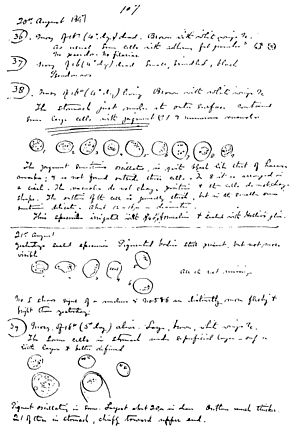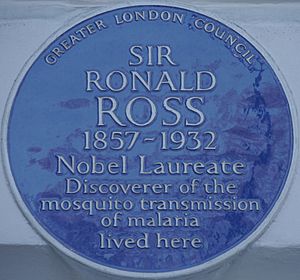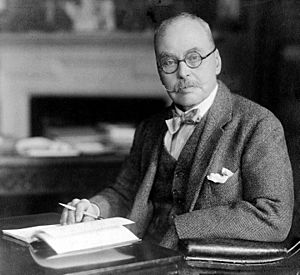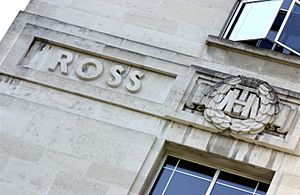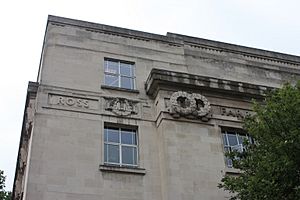Ronald Ross facts for kids
Quick facts for kids
Ronald Ross
|
|
|---|---|
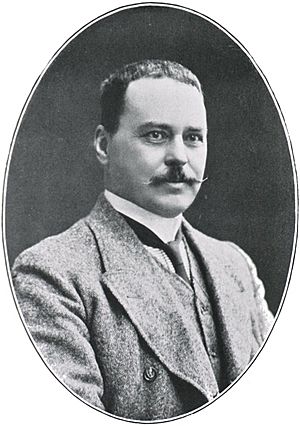 |
|
| Born | 13 May 1857 Almora, North-Western Provinces, British India
|
| Died | 16 September 1932 (aged 75) London, UK
|
| Resting place | Putney Vale Cemetery |
| Nationality | British |
| Alma mater | St Bartholomew's Hospital Medical College Society of Apothecaries |
| Known for | Discovering that the malaria parasite is transmitted by mosquitoes |
| Spouse(s) |
Rosa Bessie Bloxam
(m. 1889) |
| Awards |
|
| Scientific career | |
| Fields | Medicine |
| Institutions | Presidency General Hospital, Calcutta Liverpool School of Tropical Medicine King's College Hospital British War Office Ministry of Pensions and National Insurance Ross Institute and Hospital for Tropical Diseases |
| Author abbrev. (zoology) | Ross |
Sir Ronald Ross (born May 13, 1857 – died September 16, 1932) was a British doctor. He won the Nobel Prize in Physiology or Medicine in 1902. He earned this award for his important work on how malaria spreads. He was the first British person to win a Nobel Prize, and the first Nobel winner born outside Europe.
In 1897, Ross discovered the malaria parasite inside the stomach of a mosquito. This proved that mosquitoes carry malaria. His discovery helped create ways to fight the disease by controlling mosquitoes.
Ronald Ross was a very talented person. He wrote poems, novels, and songs. He was also an artist and a mathematician. He worked for the Indian Medical Service for 25 years. During this time, he made his big medical discovery. After leaving India, he became a professor at the Liverpool School of Tropical Medicine. Later, an institute was named after him, the Ross Institute and Hospital for Tropical Diseases, where he worked until he died.
Contents
Early Life and Education
Ronald Ross was born in Almora, India. This was in a part of India ruled by the British. He was the oldest of ten children. His father, Sir Campbell Claye Grant Ross, was a general in the British Indian Army.
When he was eight, Ronald was sent to England. He lived with his aunt and uncle on the Isle of Wight. He went to primary school there. For high school, he attended a boarding school near Southampton starting in 1869.
From a young age, Ronald loved poetry, music, books, and mathematics. When he was fourteen, he won a math prize. This prize, a book called Orbs of Heaven, made him even more interested in math. In 1873, at sixteen, he was first in a drawing exam.
Ronald wanted to be a writer. However, his father wanted him to become a doctor. So, in 1874, he enrolled at St Bartholomew's Hospital Medical College in London. He spent much of his time writing music, poems, and plays. He left the college in 1880. He became a surgeon on a ship and later qualified as a doctor in 1881. After more training, he joined the Indian Medical Service in April 1881.
Career in Medicine
Working in India
Ross arrived in India in September 1881. For many years, he worked in different cities across India and Burma. In 1883, he noticed that controlling mosquitoes could help prevent diseases. This was because mosquitoes need water to lay their eggs.
In 1894, he went to London for a break. There, he met Sir Patrick Manson, a famous doctor. Manson became Ross's mentor and encouraged him to study malaria. Manson believed India was the best place to do this research. Ross returned to India in 1895. He immediately started looking for malaria patients to study their blood.
Discovering Malaria's Link to Mosquitoes
In May 1895, Ross made an important step. He saw the early stages of the malaria parasite inside a mosquito's stomach. But his research was paused when he had to go to Bangalore to study a cholera outbreak. Bangalore did not have many malaria cases.
In April 1896, he saw a mosquito with "dappled-wings" in a strange pose. He didn't know the species at the time. In May 1896, he got sick with severe malaria himself.
After two years of trying, in July 1897, Ross finally grew 20 "brown" mosquitoes from larvae. He fed these mosquitoes blood from a patient named Husein Khan. On August 20, he found the malaria parasite inside the gut of one of these mosquitoes. He realized these were the "dappled-winged" mosquitoes, which are part of the Anopheles group.
The next day, August 21, he confirmed the parasite was growing inside the mosquito. This major discovery was published in the Indian Medical Gazette and later in the British Medical Journal. He even wrote a poem about his breakthrough.
Malaria Transmission in Birds
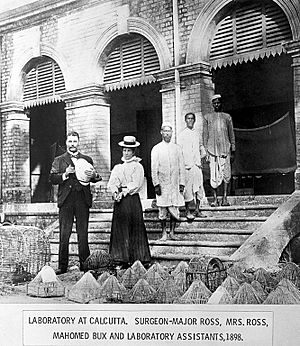
In September 1897, Ross was moved to a place in India where there was no malaria. He was very frustrated. But his mentor, Patrick Manson, helped him get a "special duty" assignment in Calcutta (now Kolkata). Ross arrived in Calcutta in February 1898.
In Calcutta, Ross studied malaria and another disease called Visceral leishmaniasis. He used a laboratory at the Presidency General Hospital. Since Calcutta didn't have many malaria patients, Manson suggested he study bird malaria. Other scientists were doing this too. Ross agreed, even though he felt he didn't need to be in India for it.
By March, he started seeing results with bird parasites. These parasites were very similar to human malaria parasites. By July 1898, Ross showed that Culex mosquitoes carried malaria in birds. On July 4, he found that the malaria parasites were stored in the mosquito's salivary gland. By July 8, he was sure that the parasites were released when the mosquito bit. He then showed how malaria could spread from infected mosquitoes to healthy sparrows. This helped him understand the full life cycle of the malaria parasite.
Later, he went to Assam to study an epidemic of Visceral leishmaniasis. He thought mosquitoes also spread this disease, but he was wrong. We now know that sandflies transmit this disease.
Working in England
In 1899, Ross left the Indian Medical Service and moved to England. He became a lecturer at the Liverpool School of Tropical Medicine. He continued his work on preventing malaria around the world. He worked in places like West Africa, Greece, and during the First World War. He also helped set up organizations to fight malaria in India and Sri Lanka.
In 1902, Ross became a Professor of Tropical Medicine at the Liverpool School of Tropical Medicine. He held this position until 1912. He later became a consultant for malaria for the British War Office.
Ross also created mathematical models to study how malaria spreads. He wrote about this in his book The Prevention of Malaria in 1910. Some of his math work was done with mathematician Hilda Phoebe Hudson.
Ross Institute and Hospital for Tropical Diseases
In 1926, the Ross Institute and Hospital for Tropical Diseases was founded. It was named in his honor. Ross became its Director-in-Chief and stayed there until he died. The institute later became part of the London School of Hygiene & Tropical Medicine.
Nobel Prize
Ronald Ross received the Nobel Prize for his discovery of the life cycle of the malaria parasite in birds. He showed that infected mosquitoes could transmit the parasite.
Another scientist, Giovanni Battista Grassi, and his team in Italy also studied malaria. They described the full life cycles of human malaria parasites in mosquitoes. When the Nobel Prize was being considered, the Nobel Committee thought about sharing the prize between Ross and Grassi. However, Ross accused Grassi of fraud. In the end, Ross received the prize alone.
Personal Life and Death
Ronald Ross was known for being a strong-willed person. He sometimes had disagreements with his colleagues. He also had a famous rivalry with G.B. Grassi.
Ross often felt that the government did not support medical research enough. In 1928, he even tried to sell his papers to get money for his wife and family. Lady Houston bought them and offered them to the British Museum. They are now kept at the London School of Hygiene & Tropical Medicine and the Royal College of Physicians and Surgeons of Glasgow.
In 1889, Ross married Rosa Bessie Bloxam. They had two daughters, Dorothy and Sylvia, and two sons, Ronald Campbell and Charles Claye. His wife died in 1931. Sadly, his son Ronald was killed in a battle in 1914, and his daughter Sylvia also died before him.
Ronald Ross died in 1932 after a long illness and an asthma attack. He was buried next to his wife at Putney Vale Cemetery.
Legacy and Recognition
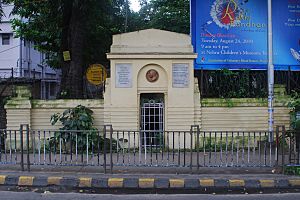
A small memorial at the SSKM Hospital in Calcutta remembers Ross's discovery. Ross himself unveiled it in 1927. The laboratory where he worked is now a malaria clinic named after him. There is also a plaque on the wall.
Sir Ronald Ross is one of 23 important people honored on a wall at the London School of Hygiene & Tropical Medicine. These pioneers were chosen for their contributions to public health.
A novel called The Calcutta Chromosome by Amitav Ghosh (published in 1995) is based on Ross's life in Calcutta.
Books by Ronald Ross
Ronald Ross was a very active writer. He often wrote poems about important events in his life. His poems showed his experiences as a doctor, his travels, and his scientific ideas. Many of his poems are in his books Selected Poems (1928) and In Exile (1931).
Some of his other notable books include:
- Report on Cholera, General Sanitation, and the Sanitary Department and Regulations, in the C. & M. Station of Bangalore (1896)
- Malarial Fever: Its Cause, Prevention and Treatment (1902)
- Researches on Malaria (1905)
- The Prevention of Malaria (1910)
- Memoirs, with a Full Account of the Great Malaria Problem and Its Solution (1923) - his autobiography
- A Priori Pathometry (with Hilda Phoebe Hudson) (1931)
He kept many of his papers, letters, and notes. These are now kept safe by the London School of Hygiene and Tropical Medicine and the Royal College of Physicians and Surgeons of Glasgow.
Awards and Honors
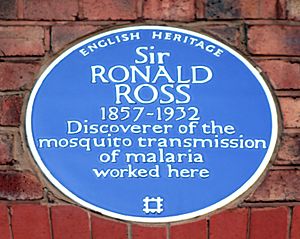
Ronald Ross received the Nobel Prize for Physiology or Medicine in 1902. The prize was given "for his work on malaria, by which he has shown how it enters the organism and thereby has laid the foundation for successful research on this disease and methods of combating it".
August 20 is celebrated as World Mosquito Day by the London School of Hygiene & Tropical Medicine. This day remembers Ross's discovery in 1897.
He became a Fellow of the Royal Society (FRS) in 1901. He was also made a Fellow of the Royal College of Surgeons of England in the same year. From 1911 to 1913, he was the Vice-President of the Royal Society.
In 1902, King Edward VII made him a Companion of the Most Honourable Order of the Bath. In 1911, he was promoted to Knight Commander of the same Order. He also received an award from Belgium, the Officer of the Order of Leopold II.
Ross received honorary memberships from many scientific societies around the world. In 1910, he received an honorary medical degree in Stockholm. His autobiography, Memoirs, won the James Tait Black Memorial Prize in 1923.
In India, Ronald Ross is highly respected for his work on malaria. This disease used to kill many people every year. Roads in many Indian cities are named after him. In Calcutta, Hospital Road was renamed Sir Ronald Ross Sarani. The regional infectious disease hospital in Hyderabad is named the Sir Ronald Ross Institute of Tropical and Communicable Diseases. The building where he discovered the malaria parasite in Secunderabad is a heritage site. The road leading to it is called Sir Ronald Ross Road.
At Christian Medical College Ludhiana, a hostel is named "Ross Hostel." Students there sometimes call themselves "Rossians."
The University of Surrey in the UK has a road named after him. Ronald Ross Primary School near Wimbledon Common is also named after him. Its school crest even has a mosquito on it.
The Sir Ronald Ross Institute of Parasitology was created in Hyderabad in his memory. In 2010, the University of Liverpool named its new biological science building "The Ronald Ross Building" in his honor. His grandson, David Ross, opened it.
See also
 In Spanish: Ronald Ross para niños
In Spanish: Ronald Ross para niños
- Mosquito-malaria theory
- History of malaria


